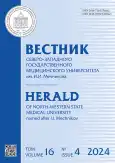Subclinical hypothyroidism — an unexpected ally in the fight against sarcopenia
- Authors: Popova K.S.1, Kinder D.S.1, Turusheva A.V.1
-
Affiliations:
- North-Western State Medical University named after I.I. Mechnikov
- Issue: Vol 16, No 4 (2024)
- Pages: 86-93
- Section: Original study article
- URL: https://journal-vniispk.ru/vszgmu/article/view/276654
- DOI: https://doi.org/10.17816/mechnikov640819
- ID: 276654
Cite item
Abstract
BACKGROUND: Thyroid hormones are essential for maintaining metabolism involved in regulating growth and development. Skeletal muscles are their primary target organ, and thyroid hormone signaling plays a role in the development, plasticity, and regeneration of skeletal muscles. Conditions such as hypo- and hyperthyroidism negatively affect the state of this tissue. However, in our earlier studies, bigger volume of thigh muscle was found to be one of the factors associated with lower mortality in individuals with high levels of thyroid-stimulating hormone.
AIM: To evaluate the impact of function thyroid gland on the risk of decreased volume of thigh muscles in older adults.
MATERIALS AND METHODS: This study was carried out on the basis of the second examination of the Crystal study of community-dwelling individuals 65+ (n = 383). The main study parameters involved thyroid-stimulating hormone, thigh muscle volume, complete blood count test, CRP, comprehensive geriatric assessment, non-communicable chronic diseases.
RESULTS: Compared with the participants with thyroid-stimulating hormone levels between 3.3 and 10.0 mIU/L, the participants with thyroid-stimulating hormone levels <0.2 mIU/L and the participants with thyroid-stimulating hormone levels between 0.2 and 3.2 mIU/L had lower body mass index, thigh muscle volume and the high prevalence of autonomy decline (p < 0.05). Even after adjusting for sex, age, malnutrition, body mass index, and autonomy decline, high thyroid-stimulating hormone levels were associated with bigger thigh muscle volume, with an odds ratio (95% confidence interval) of 3.274 (1.111–9.647).
CONCLUSIONS: The thyroid-stimulating hormone levels from 3.3 to 10.0 mIU/L increases the chances of maintaining bigger thigh muscle volume in older adults by 3.3 times.
Full Text
##article.viewOnOriginalSite##About the authors
Ksenia S. Popova
North-Western State Medical University named after I.I. Mechnikov
Email: kseniyapopova928@gmail.com
ORCID iD: 0009-0001-5075-3102
Russian Federation, Saint Petersburg
Daria S. Kinder
North-Western State Medical University named after I.I. Mechnikov
Email: da-2@mail.ru
ORCID iD: 0009-0002-2214-7890
SPIN-code: 6174-1990
Russian Federation, Saint Petersburg
Anna V. Turusheva
North-Western State Medical University named after I.I. Mechnikov
Author for correspondence.
Email: anna.turusheva@gmail.com
ORCID iD: 0000-0003-3347-0984
SPIN-code: 9658-8074
MD, Dr. Sci. (Medicine), Professor
Russian Federation, Saint PetersburgReferences
- Salvatore D, Simonides WS, Dentice M, et al. Thyroid hormones and skeletal muscle – new insights and potential implications. Nat Rev Endocrinol. 2014;10(4):206–214. doi: 10.1038/nrendo.2013.238
- Bloise FF, Cordeiro A, Ortiga-Carvalho TM. Role of thyroid hormone in skeletal muscle physiology. J Endocrinol. 2018;236(1):57–68. doi: 10.1530/JOE-16-0611
- Nappi A, Moriello C, Morgante M, et al. Effects of thyroid hormones in skeletal muscle protein turnover. J Basic Clin Physiol Pharmacol. 2024;35(4–5):253–264. doi: 10.1515/jbcpp-2024-0139
- Udayakumar N, Rameshkumar AC, Srinivasan AV. Hoffmann syndrome: presentation in hypothyroidism. J Postgrad Med. 2005;51(4):332–333.
- Ramsay ID. Muscle dysfunction in hyperthyroidism. Lancet. 1966;288(7470):931–935. doi: 10.1016/s0140-6736(66)90536-8
- Turusheva AV, Popova KS, Kinder DS. Thyroid paradox in older age. Russian family doctor. 2024;28(1):53–62. EDN: IAUECR doi: 10.17816/RFD627477
- Turusheva A, Frolova E, Hegendoerfer E, Degryse JM. Predictors of short-term mortality, cognitive and physical decline in older adults in northwest Russia: a population-based prospective cohort study. Aging Clin Exp Res. 2017;29(4):665–673. doi: 10.1007/s40520-016-0613-7
- Moon MK, Lee YJ, Choi SH, et al. Subclinical hypothyroidism has little influences on muscle mass or strength in elderly people. J Korean Med Sci. 2010;25(8):1176–1181. doi: 10.3346/jkms.2010.25.8.1176
- Szlejf C, Suemoto CK, Janovsky CCPS, et al. Thyroid function and sarcopenia: results from the ELSA-Brasil Study. J Am Geriatr Soc. 2020;68(7):1545–1553. doi: 10.1111/jgs.16416
- Netzer S, Chocano-Bedoya P, Feller M, et al. The effect of thyroid hormone therapy on muscle function, strength and mass in older adults with subclinical hypothyroidism-an ancillary study within two randomized placebo controlled trials. Age Ageing. 2023;52(1):afac326. doi: 10.1093/ageing/afac326
- Wei J, Hou S, Hei P, Wang G. Thyroid dysfunction and sarcopenia: a two-sample Mendelian randomization study. Front Endocrinol (Lausanne). 2024;15:1378757. doi: 10.3389/fendo.2024.1378757
- Zhou HY, Deng SS, Wei SY, et al. Effects of effective antithyroid therapy on adiposity and skeletal muscle in patients with hyperthyroidism across gender and age groups. Eur Rev Med Pharmacol Sci. 2023;27(13):6170–6175. doi: 10.26355/eurrev_202307_32973
- Kim BJ, Lee SH, Isales CM, et al. Association of serum thyroid-stimulating hormone with hand grip strength in community-dwelling euthyroid elderly. J Clin Endocrinol Metab. 2018;103(11):3986–3992. doi: 10.1210/jc.2018-01095
Supplementary files








